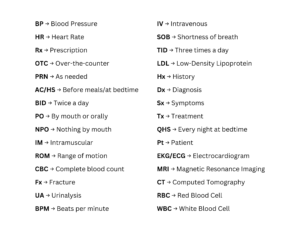30 Dec Decoding Medical Abbreviations
 Welcome to our comprehensive guide on medical abbreviations – the shorthand language of health care professionals. Initially created for quick and efficient communication, these abbreviations have become a staple in the medical world. But for those not in the medical field, these cryptic symbols and letters can often seem like a puzzle. So, this guide aims to demystify these abbreviations for everyone.
Welcome to our comprehensive guide on medical abbreviations – the shorthand language of health care professionals. Initially created for quick and efficient communication, these abbreviations have become a staple in the medical world. But for those not in the medical field, these cryptic symbols and letters can often seem like a puzzle. So, this guide aims to demystify these abbreviations for everyone.
Common Medical Abbreviations
Medical abbreviations are a language unto themselves. Here are some you’re likely to encounter:
- BP = Blood Pressure
- HR = Heart Rate
- Rx = Prescription
- OTC = Over-the-counter
- PRN = As needed
- AC/HS = Before meals/at bedtime
- BID = Twice a day
- PO = By mouth or orally
- NPO = Nothing by mouth.
- IM = Intramuscular
- IV = Intravenous
- SOB = Shortness of breath
How to Decipher Medical Abbreviations
Deciphering medical abbreviations requires understanding the context and common medical terminology. It can take some practice before you get the hang of it. That said, here are some strategies to help you out:
1. Context Clues
Look at where the abbreviation is used. Is it in a medication chart, a surgery note, or a patient’s history? The setting can give you clues about its meaning.
2. Standard Conventions
Some abbreviations have standard meanings, but be aware of variations. For example, “AC” generally means before meals, but it can vary based on the context.
3. Ask for Clarification
Healthcare professionals should be willing to explain any abbreviations you don’t understand. Never hesitate to ask for clarification to ensure proper understanding and care.
4. Use Trusted Resources
Utilize reliable medical dictionaries or online resources. Websites like the CDC or WHO often provide glossaries of terms and abbreviations.
5. Stay Updated
Medical terminology can evolve, so it’s important to stay informed about current practices and changes in the field.
 Abbreviations to Avoid
Abbreviations to Avoid
The Joint Commission has compiled a “Do Not Use” List of abbreviations that are often misinterpreted and can lead to medical errors. Make sure to always write these out. Key examples from this list include:
- U, u: Can be mistaken for “0” (zero), “4” (four), or “cc”.
- IU: Easily confused with IV or the number 10.
- Q.D., QD, q.d., qd, Q.O.D., QOD, q.o.d, qod: Too similar to one another. “O” and “I” are mistaken for each other.
- Trailing zero (X.0 mg) and Lack of leading zero (.X mg): The decimal point can be missed.
- MS, MSO4, and MgSO4: Can be confused for morphine sulfate or magnesium sulfate.
This list highlights the importance of clarity in medical communication to prevent potentially dangerous misunderstandings. For more detailed information, refer to the Joint Commission’s Do Not Use List.
Conclusion
All in all, medical abbreviations are a helpful tool in healthcare communication that can also be confusing. However, a little practice can go a long way. We hope this guide helps you understand better for safer healthcare practices. Don’t sweat it, you got this!
